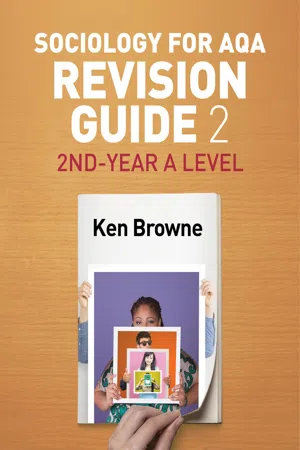
Sociology for AQA Revision Guide 2: 2nd-Year A Level
Ken Browne
- English
- ePUB (mobile friendly)
- Available on iOS & Android
Sociology for AQA Revision Guide 2: 2nd-Year A Level
Ken Browne
About This Book
The essential revision guide for A–level Sociology from trusted and best–selling author Ken Browne. Together with Sociology for AQA Revision Guide 1, this indispensable book provides everything you need to revise for the exams, with a clear topic–by–topic layout to recap key theories and central ideas. The revision guide maps perfectly onto Ken Browne, Jonathan Blundell and Pamela Law's Sociology for AQA Volume 2 with each topic cross–referenced to the main textbook so you can revisit any sections you need to. The book includes a guide to exam questions – and how to answer them – with sample worked answers showing how to achieve top marks. All specification options are covered, with exam tips throughout the book. With this revision guide to take you through the exam and Sociology for AQA Volume 2 to develop your sociological imagination, Ken Browne provides the complete resource for success in sociology.
Frequently asked questions
Information
1
PREPARING FOR THE EXAM AND ANSWERING QUESTIONS
About the A level exam
| Three exam papers. Each worth 80 marks and each 2 hours. All questions are compulsory – no choice | ||
| Paper 1: Education with Theory and Methods | Paper 2: Topics in Sociology | Paper 3: Crime and Deviance with Theory and Methods |
Education: 50 marks One 4-mark question: Outline two . . . (ways/factors/reasons, etc.) (4 marks) One 6-mark question: Outline three . . . (6 marks) One 10-mark question, linked to an Item: Applying material from Item [A], analyse two . . . (10 marks) One 30-mark extended essay, linked to an Item: Applying material from Item [B] and your knowledge, evaluate . . . (the view/usefulness of/explanations, etc.) (30 marks) Methods in Context: 20 marks One 20-mark essay, linked to an Item, on applying a particular research method to a particular educational context/situation: Applying material from Item [C] and your knowledge of research methods, evaluate the strengths and limitations of using (a research method) to investigate (an issue in education) (20 marks) Theory and Methods: 10 marks One 10-mark question: Outline and explain two . . . (reasons/ways, etc.) (10 marks) | Section A: 40 marks Choose ONE from Culture and Identity; Families and Households; Health; Work, Poverty and Welfare. One 10-mark question: Outline and explain two . . . (reasons/explanations, etc.) (10 marks) One 10-mark question, linked to an Item: Applying material from Item [A], analyse two . . . (10 marks) One 20-mark question, linked to an Item: Applying material from Item [B] and your knowledge, evaluate . . . (the view/usefulness of/explanations, etc.) (20 marks) Section B: 40 marks Choose ONE from Beliefs in Society; Global Development; The Media; Stratification and Differentiation. The questions follow the same format as those in Section A | Crime and Deviance: 50 marks One 4-mark question: Outline two . . . (ways/factors/reasons, etc.) (4 marks) One 6-mark question: Outline three . . . (6 marks) One 10-mark question, linked to an Item: Applying material from Item [A], analyse two . . . (10 marks) One 30-mark extended essay, linked to an Item: Applying material from Item [B] and your knowledge, evaluate . . . (the view/usefulness of/explanations, etc.) (30 marks) Theory and Methods: 30 marks One 10-mark question: Outline and explain two . . . (reasons/explanations etc.) (10 marks) One 20-mark question, linked to an Item: Applying material from Item [C] and your knowledge, evaluate . . . (the view/usefulness of/explanations, etc.) (20 marks) |
What will you be examined on?
AO1: Knowledge and understanding (44% of the marks)
AO2: Application (31% of the marks)
AO3: Analysis and evaluation (25% of the marks)
EXAM TIPS:
- ➤ Always focus on the wording of the question and apply what you know to the specific issue being asked about – don’t generalise.
- ➤ Where the question involves an Item, you must refer to that Item: e.g. ‘As shown by Item [A] . . .’
How to answer 4- and 6-mark questions
Outline two/three . . . (ways/factors/reasons/advantages/differences, etc.).